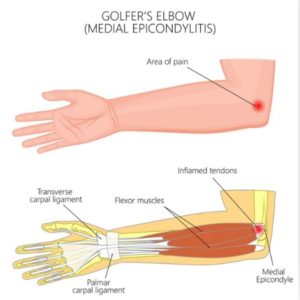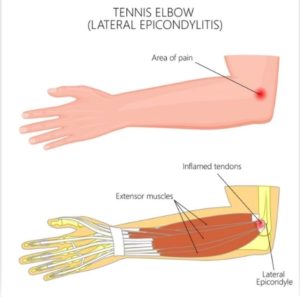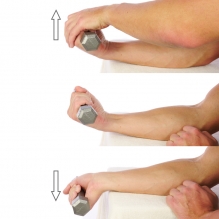
Elbow Pain Affecting Your Game?
Golfer’s and tennis elbow are two common injuries that may be contributing to your elbow pain. Both conditions are a form of epicondylitis, which is defined as inflammation or damage to the epicondyle (bone) or surrounding tissues (tendons).
Medial epicondylitis or “golfer’s elbow” is associated with pain along the inner side of the elbow and affects the flexor tendons of your forearm. Lateral epicondylitis or “tennis elbow” affects the extensor tendons and is associated with pain on the outer side of the elbow.
These conditions are considered to be overuse injuries caused by repetitive motions, especially gripping and grasping. Over time these repeated movements exert enough stress on the tendons to lead to soft-tissue damage and inflammation.
Although the repetitive nature of golf and racquet sports is often a precursor to injury, athletes are not the only people who suffer from epicondylitis. Many people with these conditions participate in work or recreational activities that require repetitive and vigorous use of the forearm muscles such as gardening, rock climbing, using hand and power tools, and carrying a briefcase. Painters, plumbers, carpenters, auto workers and cooks have also been found to be at higher risk for overuse injuries.
Signs and Symptoms
- Gradual onset of elbow pain
- Weakness and/or painful grip (i.e. opening jars, lifting objects)
- Palpable tenderness at elbow
Treatment
- Rest
- The first step toward recovery is to give your arm proper rest. This means that you may have to reduce or stop participation in sports or heavy work activities. Icing for 10-15 minutes after participation in activity can help reduce inflammation.
- Brace
- Using a counterforce brace or strap centered over the back of your forearm may also help relieve symptoms of epicondylitis by reducing stress on the muscles and tendons.
- Physical Therapy
- See below for examples of strength and flexibility exercises that may be prescribed as a part of your treatment.
Prevention
- Warm up before activity.
- Be sure to use proper form/technique during your swings.
- Check your equipment.
- Racquets should be strung properly and sized correctly.
- If string tension is too high it can lead to increased stress loads in the elbow.
- Oversized racquets that are too heavy or have too big of a grip can also contribute to injury.
- Consider using lighter clubs as opposed to heavier golfing irons
- Racquets should be strung properly and sized correctly.
- Maintain physical fitness.
- Both general conditioning and specific exercises to improve the strength and flexibility of the muscles of the forearm can help reduce your risk of injury.
Approximately 90% of patients have success with nonsurgical treatment. Consult with your doctor or physical therapist if your pain is recurring, does not improve, or worsens over time.
Exercises
Golfer’s Elbow:
Wrist Flexor Stretch
- Extend your arm in front of you with your palm up.
- With your other hand, gently bend your wrist until you feel a mild to moderate stretch in your forearm.
- Hold for 30 seconds and repeat 3 times.
Wrist Flexion Eccentric
-
Hold a weight in your hand on the side of your body that is affected.
-
Rest your arm on your thigh or a table with your palm facing upwards.
-
Gradually lower the hand with the weight in it.
-
Use your free hand to help move the weight back to its original position.
-
Repeat 10 to 15 times for 3 sets.
Tennis Elbow
Wrist Extensor Stretch
- Extend your arm in front of you with your palm facing down.
- With your other hand, gently flex your wrist until you feel a mild to moderate stretch along the top of your forearm.
- Hold for 30 seconds and repeat 3 times.
Wrist Extension Eccentric
-
Hold a weight in your hand on the side of your body that is affected.
-
Rest your arm on your thigh or a table with your palm facing downwards.
-
Use your free hand to lift the weight up into a raised position.
-
Gradually lower the hand with the weight in it.
- Use your free hand to help move the weight back to the starting position.
-
Repeat 10 to 15 times for 3 sets.
References:
https://www.health.harvard.edu/pain/stop-elbow-pain-and-stay-in-the-game
https://orthoinfo.aaos.org/en/diseases–conditions/tennis-elbow-lateral-epicondylitis/
https://www.healthline.com/health/exercises-for-golfers-elbow-2






